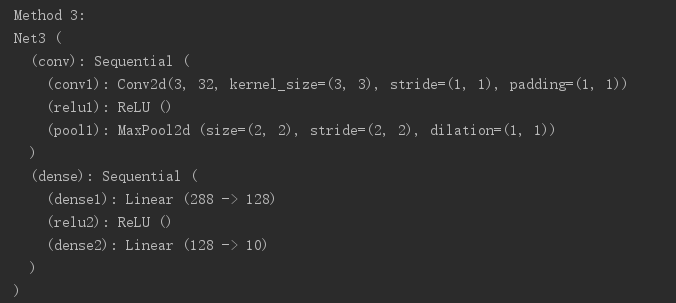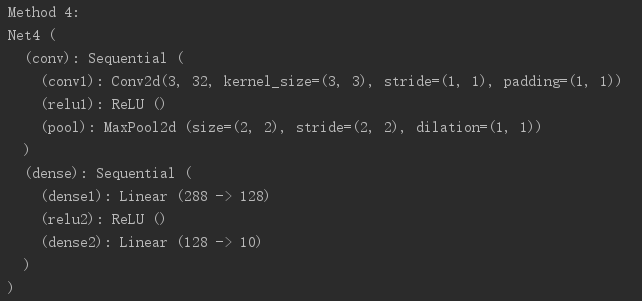转载自这里
利用pytorch来构建网络模型有很多种方法,以下简单列出其中的四种。
假设构建一个网络模型如下:
卷积层--》Relu层--》池化层--》全连接层--》Relu层--》全连接层
利用pytorch来构建网络模型有很多种方法,以下简单列出其中的四种。
假设构建一个网络模型如下:
卷积层--》Relu层--》池化层--》全连接层--》Relu层--》全连接层
首先导入几种方法用到的包:
import torch import torch.nn.functional as F from collections import OrderedDict
第一种方法
# Method 1 -----------------------------------------
class Net1(torch.nn.Module):
def init(self):
super(Net1, self).init()
self.conv1 = torch.nn.Conv2d(3, 32, 3, 1, 1)
self.dense1 = torch.nn.Linear(32 * 3 * 3, 128)
self.dense2 = torch.nn.Linear(128, 10)
</span><span style="color: #0000ff;">def</span><span style="color: #000000;"> forward(self, x):
x </span>= F.max_pool2d(F.relu(self.conv(x)), 2<span style="color: #000000;">)
x </span>= x.view(x.size(0), -1<span style="color: #000000;">)
x </span>=<span style="color: #000000;"> F.relu(self.dense1(x))
x </span>=<span style="color: #000000;"> self.dense2(x)
</span><span style="color: #0000ff;">return</span><span style="color: #000000;"> x
print(“Method 1:”)
model1 = Net1()
print(model1)

这种方法比较常用,早期的教程通常就是使用这种方法。
第二种方法
# Method 2 ------------------------------------------ class Net2(torch.nn.Module): def __init__(self): super(Net2, self).__init__() self.conv = torch.nn.Sequential( torch.nn.Conv2d(3, 32, 3, 1, 1), torch.nn.ReLU(), torch.nn.MaxPool2d(2)) self.dense = torch.nn.Sequential( torch.nn.Linear(32 * 3 * 3, 128), torch.nn.ReLU(), torch.nn.Linear(128, 10) )</span><span style="color: #0000ff;">def</span><span style="color: #000000;"> forward(self, x): conv_out </span>=<span style="color: #000000;"> self.conv1(x) res </span>= conv_out.view(conv_out.size(0), -1<span style="color: #000000;">) out </span>=<span style="color: #000000;"> self.dense(res) </span><span style="color: #0000ff;">return</span><span style="color: #000000;"> out
print(“Method 2:”)
model2 = Net2()
print(model2)

这种方法利用torch.nn.Sequential()容器进行快速搭建,模型的各层被顺序添加到容器中。缺点是每层的编号是默认的阿拉伯数字,不易区分。
第三种方法:
# Method 3 ------------------------------- class Net3(torch.nn.Module): def __init__(self): super(Net3, self).__init__() self.conv=torch.nn.Sequential() self.conv.add_module("conv1",torch.nn.Conv2d(3, 32, 3, 1, 1)) self.conv.add_module("relu1",torch.nn.ReLU()) self.conv.add_module("pool1",torch.nn.MaxPool2d(2)) self.dense = torch.nn.Sequential() self.dense.add_module("dense1",torch.nn.Linear(32 * 3 * 3, 128)) self.dense.add_module("relu2",torch.nn.ReLU()) self.dense.add_module("dense2",torch.nn.Linear(128, 10))</span><span style="color: #0000ff;">def</span><span style="color: #000000;"> forward(self, x): conv_out </span>=<span style="color: #000000;"> self.conv1(x) res </span>= conv_out.view(conv_out.size(0), -1<span style="color: #000000;">) out </span>=<span style="color: #000000;"> self.dense(res) </span><span style="color: #0000ff;">return</span><span style="color: #000000;"> out
print(“Method 3:”)
model3 = Net3()
print(model3)

这种方法是对第二种方法的改进:通过add_module()添加每一层,并且为每一层增加了一个单独的名字。
第四种方法:
# Method 4 ------------------------------------------ class Net4(torch.nn.Module): def __init__(self): super(Net4, self).__init__() self.conv = torch.nn.Sequential( OrderedDict( [ ("conv1", torch.nn.Conv2d(3, 32, 3, 1, 1)), ("relu1", torch.nn.ReLU()), ("pool", torch.nn.MaxPool2d(2)) ] ))self.dense </span>=<span style="color: #000000;"> torch.nn.Sequential( OrderedDict([ (</span><span style="color: #800000;">"</span><span style="color: #800000;">dense1</span><span style="color: #800000;">"</span>, torch.nn.Linear(32 * 3 * 3, 128<span style="color: #000000;">)), (</span><span style="color: #800000;">"</span><span style="color: #800000;">relu2</span><span style="color: #800000;">"</span><span style="color: #000000;">, torch.nn.ReLU()), (</span><span style="color: #800000;">"</span><span style="color: #800000;">dense2</span><span style="color: #800000;">"</span>, torch.nn.Linear(128, 10<span style="color: #000000;">)) ]) ) </span><span style="color: #0000ff;">def</span><span style="color: #000000;"> forward(self, x): conv_out </span>=<span style="color: #000000;"> self.conv1(x) res </span>= conv_out.view(conv_out.size(0), -1<span style="color: #000000;">) out </span>=<span style="color: #000000;"> self.dense(res) </span><span style="color: #0000ff;">return</span><span style="color: #000000;"> out
print(“Method 4:”)
model4 = Net4()
print(model4)

是第三种方法的另外一种写法,通过字典的形式添加每一层,并且设置单独的层名称。
完整代码:


import torch import torch.nn.functional as F from collections import OrderedDict
# Method 1 -----------------------------------------
class Net1(torch.nn.Module):
def init(self):
super(Net1, self).init()
self.conv1 = torch.nn.Conv2d(3, 32, 3, 1, 1)
self.dense1 = torch.nn.Linear(32 * 3 * 3, 128)
self.dense2 = torch.nn.Linear(128, 10)
</span><span style="color: #0000ff;">def</span><span style="color: #000000;"> forward(self, x):
x </span>= F.max_pool2d(F.relu(self.conv(x)), 2<span style="color: #000000;">)
x </span>= x.view(x.size(0), -1<span style="color: #000000;">)
x </span>=<span style="color: #000000;"> F.relu(self.dense1(x))
x </span>=<span style="color: #000000;"> self.dense2()
</span><span style="color: #0000ff;">return</span><span style="color: #000000;"> x
print(“Method 1:”)
model1 = Net1()
print(model1)
# Method 2 ------------------------------------------
class Net2(torch.nn.Module):
def init(self):
super(Net2, self).init()
self.conv = torch.nn.Sequential(
torch.nn.Conv2d(3, 32, 3, 1, 1),
torch.nn.ReLU(),
torch.nn.MaxPool2d(2))
self.dense = torch.nn.Sequential(
torch.nn.Linear(32 * 3 * 3, 128),
torch.nn.ReLU(),
torch.nn.Linear(128, 10)
)
</span><span style="color: #0000ff;">def</span><span style="color: #000000;"> forward(self, x):
conv_out </span>=<span style="color: #000000;"> self.conv1(x)
res </span>= conv_out.view(conv_out.size(0), -1<span style="color: #000000;">)
out </span>=<span style="color: #000000;"> self.dense(res)
</span><span style="color: #0000ff;">return</span><span style="color: #000000;"> out
print(“Method 2:”)
model2 = Net2()
print(model2)
# Method 3 -------------------------------
class Net3(torch.nn.Module):
def init(self):
super(Net3, self).init()
self.conv=torch.nn.Sequential()
self.conv.add_module(“conv1”,torch.nn.Conv2d(3, 32, 3, 1, 1))
self.conv.add_module(“relu1”,torch.nn.ReLU())
self.conv.add_module(“pool1”,torch.nn.MaxPool2d(2))
self.dense = torch.nn.Sequential()
self.dense.add_module(“dense1”,torch.nn.Linear(32 * 3 * 3, 128))
self.dense.add_module(“relu2”,torch.nn.ReLU())
self.dense.add_module(“dense2”,torch.nn.Linear(128, 10))
</span><span style="color: #0000ff;">def</span><span style="color: #000000;"> forward(self, x):
conv_out </span>=<span style="color: #000000;"> self.conv1(x)
res </span>= conv_out.view(conv_out.size(0), -1<span style="color: #000000;">)
out </span>=<span style="color: #000000;"> self.dense(res)
</span><span style="color: #0000ff;">return</span><span style="color: #000000;"> out
print(“Method 3:”)
model3 = Net3()
print(model3)
# Method 4 ------------------------------------------
class Net4(torch.nn.Module):
def init(self):
super(Net4, self).init()
self.conv = torch.nn.Sequential(
OrderedDict(
[
(“conv1”, torch.nn.Conv2d(3, 32, 3, 1, 1)),
(“relu1”, torch.nn.ReLU()),
(“pool”, torch.nn.MaxPool2d(2))
]
))
self.dense </span>=<span style="color: #000000;"> torch.nn.Sequential(
OrderedDict([
(</span><span style="color: #800000;">"</span><span style="color: #800000;">dense1</span><span style="color: #800000;">"</span>, torch.nn.Linear(32 * 3 * 3, 128<span style="color: #000000;">)),
(</span><span style="color: #800000;">"</span><span style="color: #800000;">relu2</span><span style="color: #800000;">"</span><span style="color: #000000;">, torch.nn.ReLU()),
(</span><span style="color: #800000;">"</span><span style="color: #800000;">dense2</span><span style="color: #800000;">"</span>, torch.nn.Linear(128, 10<span style="color: #000000;">))
])
)
</span><span style="color: #0000ff;">def</span><span style="color: #000000;"> forward(self, x):
conv_out </span>=<span style="color: #000000;"> self.conv1(x)
res </span>= conv_out.view(conv_out.size(0), -1<span style="color: #000000;">)
out </span>=<span style="color: #000000;"> self.dense(res)
</span><span style="color: #0000ff;">return</span><span style="color: #000000;"> out
print(“Method 4:”)
model4 = Net4()
print(model4)
